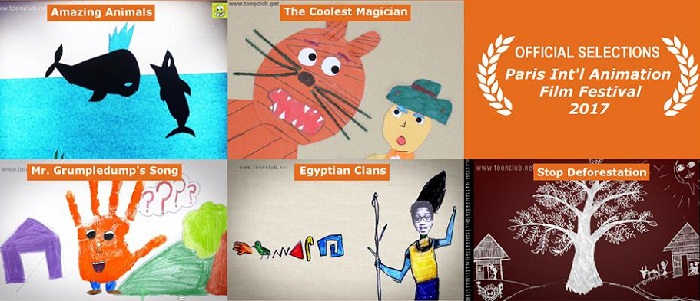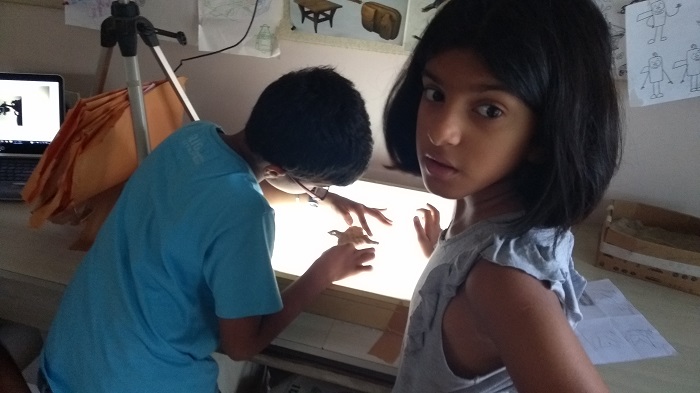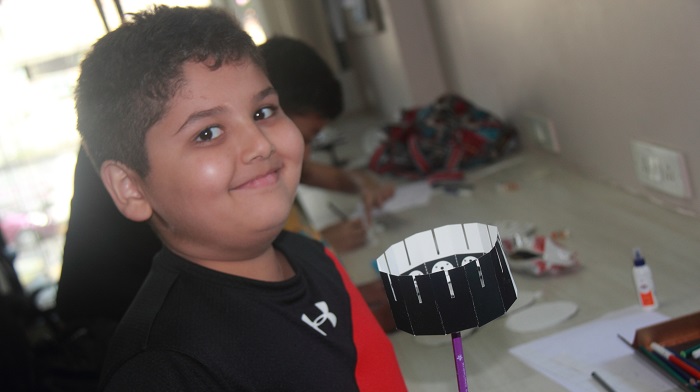
The Paris International Film Festival 2017 is almost here, and these prodigious, young animation talents from Toon Club Mumbai will put India on the global animation map. Their films have been selected for the annual festival and will be gunning for the top honours.
Animation Xpress got in touch with Ruchee Ajwani (grade seven student of Ecole Mondiale in 2016), Tavishi Kapoor (a student of Cartoon Walk program at American School of Bombay and Toon’in on Saturdays Program at Toon Club) and Shivani Shrotri (grade six student of Ecole Mondiale in 2017) who along with their groups, produced animation films that have caught the international market by awe.
Why did you learn animation?
Ruchee: Last year in the arts class, we were learning about Warli (a style of tribal art) and also discussed the issue of deforestation. We felt that we needed a method to propagate this using art. So we thought animation is the best bet because it is extremely relevant in modern age and also the best way to spread awareness in a unique way.

Tavishi: I started learning animation because it is a nice form of art. It is a great skill to learn and helps me beat stress. It’s just fun doing animation.
Shivani: During our art class, we were taught the history of arts. We learnt about the Egyptians and other case paintings. So we thought while doing this, we could also express ourselves. Hence we thought animation would be a good choice.
What is the best part about animation according to you?
Ruchee: I think animation gives us freedom to express our ideas while still using a fixed format. It is also very intriguing and fascinating.
Tavishi: It’s a way to make a non-living thing move. It’s like magic. Many people wonder how you do it, and knowing it is really good.
Shivani: I think the best thing is using the light table and morphing. It’s quite fun!
When you first came to know your film was selected for the PIAFF, what was your reaction?
Ruchee: This was actually a group work by which we did our own pieces of work and later combined them together. Yet, we were honoured to get this opportunity.
Tavishi: I feel like I’m already an animator and felt very happy that such a big thing has happened. My teachers congratulated me as well and they liked my work too.
Shivani: Since this was a collaborative work, all of us were very excited. It is the first film to get selected and it is also one of our first animation at middle year programme (MYP) in Ecole Mondiale school.
Can you tell us about your film in short?
Ruchee: We tried to propagate the use of Warli because it is a tradition that has helped us express ourselves throughout these years, but felt the need to express further. Also, deforestation is a relevant issue that people should know of.
Tavishi: The first film was Amazing Animals and we were working in a pair. It has two animals, one controlled by each person. This is a silhouette film. We took a black paper, made the shapes of our animals and cut them out. We did not make the whole animal at once, but went about it part-by-part. We made the hands, the legs, and so on, and then joined them with a thread. Due to this we were able to move the animal, little by little and clicked the picture.

Shivani: We worked on Egyptian arts and hieroglyphics. We had to write our names in hieroglyphics and also make characters. The morphing process involved was quite challenging because it was the first time we were doing it.
What were your parents’ reactions?
Ruchee: Our parents were very pleased with our work. They also encouraged us to continue in future.
Do you wish to be an animator in future?
Ruchee: I’m not very sure of that yet, but I’m very fascinated by art and interested in that. So if presented with an opportunity, then I’d definitely take up the chance.
Tavishi: I really wish to be an animator in future. I want to make films. I’ve already written a few scripts. I want to make a film about how women are abused and want to stop that.
Shivani: Though I find it fascinating and interesting, am not sure yet. But I’m definitely going to think about it.

Animation Xpress also caught up with Tavishi’s mother Dhaarna Arora, who talks about nurturing the young talent, narrow societal views and the role Toon Club played in shaping her child’s animation skills.
Why did you choose to let your kid learn animation?
One reason was obviously because she is a creative child. Additionally it is a good medium and a mechanism to express her thoughts and ideas. That’s the reason we enrolled her for animation.
Do you see her taking up animation as a career? Or do you think she should go in her conventional line of engineering or MBA?
That’s exactly what we don’t want her to do! But you never know. It is ultimately her choice and if she chooses animation as her career option, then we would be happy.
What was your reaction on her film being selected?
I think it’s amazing. It’s a great motivation. Gratification normally happens over a period of time. But when something like this happens, when you get appreciation at a forum like this, it’s a huge motivator for the child. It’s extremely gratifying.
What are your views on animation in India?
I think there is a lot of ground we have to cover. As a society we’ve been caught up with something conventional, so somehow children are not encouraged to be creative and original. That’s where we lack as a society. So when I compare the animation of the west to that of India, we have a lot of ground to cover, whether it is the quality of the animation or the originality or the finesse.
Do you have any association with animation?
No. I’m in a very conventional line of job.
Your views on Toon Club as a learning phase?
The experience with Tehzeeb at Toon Club has been amazing. We started with a very small program at American school and that’s how we got to know Tehzeeb. We enrolled for one module, then another, and then another one. She is extremely child-friendly and has been truly able to enthuse the kids.

The other day my child was mentioning I should never be missing the classes as it is really important. It’s a great value addition. She is following it the conventional way so with the whole drawing, stitching people together and doing the voice-over, she is really starting with the basics. If the kids are interested in technology, they can take that up anytime. But something like this, which starts with the basics, tries to save this whole age-old art of animation, is something which Tehzeeb is doing really well.
When do you think should parents let their children learn animation? What’s the right age?
I’d say anytime after seven. First time when Tavishi was introduced to animation, she was almost eight. So she started as early as that. For a child to understand the nuances, such as head-turning, they should be seven to eight years old. Anywhere between eight to ten years is a good, ripe age to start.

